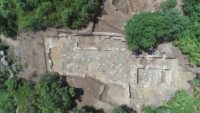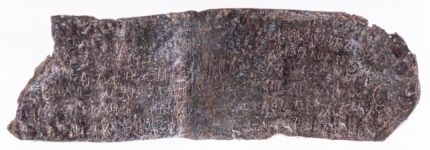 A lead plate amulet discovered in the medieval fortress of Balak Dere near the village of Huhla, in southern Bulgaria, bears one of the earliest known inscriptions in Cyrillic. The amulet was unearthed last autumn in a layer with artifacts dating to the first half of the 10th century. Epigraphic analysis of the inscription confirms the date based on the archaic style of lettering.
A lead plate amulet discovered in the medieval fortress of Balak Dere near the village of Huhla, in southern Bulgaria, bears one of the earliest known inscriptions in Cyrillic. The amulet was unearthed last autumn in a layer with artifacts dating to the first half of the 10th century. Epigraphic analysis of the inscription confirms the date based on the archaic style of lettering.
It was found folded in half and in dire need of cleaning. The inscription was not initially visible to the naked eye. The photographer documenting the find spotted the writing first, and only after an cleaning and conservation could researchers begin to decipher the inscriptions. Reflectance Transformation Imaging (RTΙ) photography was used to make out the hard-to-read lettering.
There are seven rows of text on the inside of the folded rectangular plate and four rows on the outside. They contain prayers for the protection of named individuals. The plate was worn as a pendant to protect the wearer.
It was believed that such apotropaic amulets protected their owner from the evil eye, magic spells and disease. Around 50-60 such 10th century artefacts found in Northeastern Bulgaria have so far been studied, but the find in Balak Dere is unique, with no equivalent so far, researchers say.
“The difference is that what we have here is a supplication, even the names of the supplicants are known – Nikola and Pavel,” [excavation leader] Ivaylo Kanev explains. “They are asking St. Dimitar to intercede with God on their behalf and protect them from such-and-such calamities, as, the authors say, and I will quote the last line which is very canonical and astonishing, because we have never seen anything like it before: “…wash his face with grace, exonerate the shame, heal, oh, Saint, because His is the glory, and the honour, and the state, now and forever, Amin!” Very well structured, like a canon, there are no simple wishes here. That is the other novelty.”
 Recent excavations at the hilltop site have uncovered evidence that the fortress was in use off and on from the 4th until the early 13th centuries. It was part of a system of fortresses built in the middle of the 4th century to defend the imperial capital of Constantinople. It was burned down at the end of the 5th century but quickly rebuilt.
Recent excavations at the hilltop site have uncovered evidence that the fortress was in use off and on from the 4th until the early 13th centuries. It was part of a system of fortresses built in the middle of the 4th century to defend the imperial capital of Constantinople. It was burned down at the end of the 5th century but quickly rebuilt.
It was destroyed again by the Avars in the early 7th century and was only reoccupied in the 10th century when troops of Bulgarian Tsar Simeon I the Great (r. 893-927) used it during the king’s wars against the Byzantine Empire. What went around came around in the 12th century when the troops of Byzantine Emperor Alexios I Komnenos (r. 1081-1118) occupied the fortress. The site was permanently abandoned in the first quarter of the 13th century.
The archaeological layer the lead plate amulet was found in spurred archaeologists to compare the inscription to Cyrillic writing from Tsar Simeon’s rule. Cyrillic was developed in the 890s at the Preslav Literary School in the Bulgarian capital of Pliska. The earliest dateable Cyrillic inscriptions on the record have been found there, with the earliest dating to 921. Simeon’s Bulgarian troops were at Balak Dere between 916 and 927, so this amulet may be THE earliest known Cyrillic inscription, not just one of the earliest.
